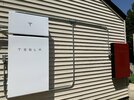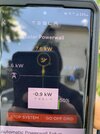oholladay
Member
I confirmed Tesla that my Powerwalls were manufactured in November 2020, and this method is consistent with that. My SNs start with TG120310, TG120314, and TG120315, which would indicate manufacturing in the first and second weeks of November. They were installed the third week.That is at least logical. It is not what I was told about my units, but I guess time will tell.
However, my part numbers are all 1092170-05-J. Wondering if the main difference in the new ones is a newer inverter model and thus some manufactured during this "transition" time period used old inverters that were still in the warehouse.




